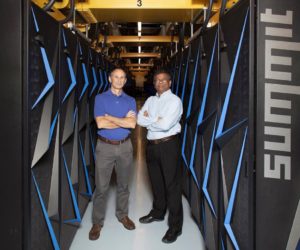
John Turner (left) and Suresh Babu, pictured here with the Summit supercomputer at ORNL, are part of a multi-laboratory team developing an exascale computing application to simulate additive manufacturing of born-qualified parts for critical systems. Photo courtesy of Oak Ridge National Laboratory, U.S. Dept. of Energy.
In this video from the HPC User Forum in Detroit, John Turner, Oak Ridge National Laboratory presents: ExaAM – Transforming Additive Manufacturing through Exascale Simulation.
The goal of ExaAM is to develop an AM simulator that will give researchers a tool to determine the best method to print parts with complex geometries and site-specific properties, complemented by real-time, in situ process visualization, analyses and optimization. Coupled with a modern computer-aided design tool, the simulator will allow the routine use of AM to build unique, qualifiable metal alloy parts across many industries relevant to DOE.
John Turner is Group Leader of the Computational Engineering & Energy Sciences Group (CEES) at Oak Ridge National Laboratory (ORNL), ORNL lead for the High Performance Computing for Manufacturing (HPC4Mfg) program[1], Principal Investigator for the Consortium for Advanced Battery Simulation (CABS)[2] and the Exascale Additive Manufacturing (ExaAM) project[3]. He is also a Joint Faculty Professor in both the Bredesen Center for Interdisciplinary Research and Graduate Education at the Univ. of Tennessee in Knoxville and the National Center for Computational Engineering at the Univ. of Tennessee in Chattanooga.
- From 2010 through 2016 Dr. Turner served on the leadership team for the Consortium for Advanced Simulation of Light Water Reactors (CASL)[4], first as a core member of the proposal team, then as the Virtual Reactor (and later Physics) Integration Focus Area Lead and finally as Chief Computational Scientist.
- After completion of a Ph.D. in Nuclear Engineering from North Carolina State University, Dr. Turner joined Los Alamos National Laboratory (LANL) and worked in radiation transport, fluid flow, and numerical methods. He was one of the original developers of the Truchas computer code, developed as part of the NNSA/ASC program for metal casting and welding simulation, and now being applied to metal additive manufacturing.
- In 1997 John left LANL to join Blue Sky Studios, a computer animation company outside New York City, earning credits on the Academy Award-nominated feature film “Ice Age” as well as the Oscar-winning short animated film “Bunny”.
- In 2001 Dr. Turner returned to LANL and became Group Leader of the Computational Physics Group (CCS-2), a group of over 70 Ph.D. scientists, students, and other staff conducting research in modeling & simulation of physical phenomena for applications ranging from ocean & climate to nuclear weapons and nuclear energy systems. He led an internally-funded R&D effort to investigate hybrid computing architectures such as video cards (GPUs) as high-performance co-processors, and subsequently led the Advanced Algorithms & Applications team for the Roadrunner supercomputer. Roadrunner augmented standard processors with enhanced versions of the processor used in PlayStation 3 game consoles, and was the first system to achieve a sustained performance exceeding 1 PetaFlop/s (1015 operations per second).
- In 2008 John moved to ORNL to form CEES, a new group focused on developing and applying advanced simulation tools to applications such as nuclear energy and electrical energy storage.
The next HPC User Forum takes place Oct. 1-2, 2018 in Stuttgart, Germany.




